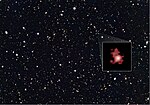astro.wikisort.org - Galaxy
Crater 2 is a low-surface-brightness dwarf satellite galaxy of the Milky Way,[1] located approximately 380,000 ly from Earth. Its discovery in 2016 revealed significant gaps in astronomer's understanding of galaxies possessing relatively small half-light diameters and suggested the possibility of many undiscovered dwarf galaxies orbiting the Milky Way.[2] Crater 2 was identified in imaging data from the VST ATLAS survey.[2]
| Crater 2 | |
|---|---|
| Observation data (J2000.0 epoch) | |
| Constellation | Crater[1] |
| Right ascension | 11h 49m 14.400s 177.310°±0.03°[1] |
| Declination | −18° 24′ 46.80″ −18.413°±0.03°[1] |
| Distance | 383,000 ly (117.5 kpc)[1] |
| Apparent magnitude (V) | 12.15 mag[1] |
| Absolute magnitude (V) | −8.2±0.1 mag[1] |
| Characteristics | |
| Type | dSph[1] |
| Apparent size (V) | 62.4′ (rh=31.2′ ± 2.5′)[1] 6,950 ly (2,132 pc) rh=1066pc ± 84pc[1] |
| Notable features | 4th largest satellite galaxy to Milky Way[1] |
The galaxy has a half-light radius of ∼1100 pc, making it the fourth largest satellite of the Milky Way.[1] It has an angular size about double of that of the moon.[2][3] Despite the large size, Crater 2 has a surprisingly low surface brightness, implying that it is not very massive.[4] In addition, its velocity dispersion is also low, suggesting it may have formed in a halo of low dark matter density.[5] Alternatively, it may be a result of tidal interactions with it and larger galaxies, such as the Milky Way and the Large Magellanic Cloud,[4] but according to some simulations, this would not explain the relatively large size.[5]
See also
- Antlia 2
- Satellite galaxies of the Milky Way
- Local Group
References
- Torrealba, G.; Koposov, S. E.; Belokurov, V.; Irwin, M. (2016). "The feeble giant. Discovery of a large and diffuse Milky Way dwarf galaxy in the constellation of Crater". Monthly Notices of the Royal Astronomical Society. 459 (3): 2370–2378. arXiv:1601.07178. Bibcode:2016MNRAS.459.2370T. doi:10.1093/mnras/stw733.
- Croswell, Ken (14 April 2016). "Never-before-seen galaxy spotted orbiting the Milky Way". New Scientist. Retrieved 14 April 2016.
- Howard, Jacqueline (2016-04-16). "Elusive Dwarf Galaxy Found Orbiting Our Milky Way". Huffington Post. Retrieved 2016-04-19.
- Ji, Alexander P.; Koposov, Sergey E.; Li, Ting S.; Erkal, Denis; Pace, Andrew B.; Simon, Joshua D.; Belokurov, Vasily; Cullinane, Lara R.; Da Costa, Gary S.; Kuehn, Kyler; Lewis, Geraint F.; MacKey, Dougal; Shipp, Nora; Simpson, Jeffrey D.; Zucker, Daniel B.; Hansen, Terese T.; Bland-Hawthorn, Joss; S5 Collaboration (2021). "Kinematics of Antlia 2 and Crater 2 from the Southern Stellar Stream Spectroscopic Survey (S 5)". The Astrophysical Journal. 921 (1): 32. arXiv:2106.12656. Bibcode:2021ApJ...921...32J. doi:10.3847/1538-4357/ac1869. S2CID 235624056.
- Borukhovetskaya, Alexandra; Navarro, Julio F.; Errani, Raphaël; Fattahi, Azadeh (2022). "Galactic tides and the Crater II dwarf spheroidal: A challenge to LCDM?". Monthly Notices of the Royal Astronomical Society. 512 (4): 5247–5257. arXiv:2112.01540. Bibcode:2022MNRAS.512.5247B. doi:10.1093/mnras/stac653.
External links
На других языках
[de] Crater-II-Zwerggalaxie
Die Crater-II-Zwerggalaxie, kurz auch Crater II oder Crater 2, ist eine im Jahr 2016 entdeckte Zwerggalaxie des Typs dSph im Sternbild Becher in der Lokalen Gruppe und eine der Satellitengalaxien der Milchstraße.- [en] Crater 2 Dwarf
[ru] Чаша 2
Ча́ша 2 (Кра́тер 2, Crater 2, Cra 2) — карликовая сфероидальная галактика, спутник Млечного Пути. Открыта в январе 2016 года в результате анализа данных обзора ATLAS телескопа VST, набранных до сентября 2015 года. Галактика расположена на расстоянии 117,5 ± 1,1 килопарсека от Солнца, имеет почти сферическую форму (эксцентриситет эллипсоида не превосходит 0,1). Её угловой радиус по половинной изофоте в оптическом диапазоне равен 31,2 ± 2,5 угловой минуты, что примерно в два раза больше угловых размеров полной Луны. Линейный радиус по половинной изофоте равен 1066 ± 84 пк. Средний возраст составляющих её звёзд оценивается как 10 ± 1 млрд. лет. Средняя металличность равна −1,7 ± 0,1 солнечной (то есть содержание тяжёлых элементов в 40…60 раз меньше, чем солнечное).Другой контент может иметь иную лицензию. Перед использованием материалов сайта WikiSort.org внимательно изучите правила лицензирования конкретных элементов наполнения сайта.
WikiSort.org - проект по пересортировке и дополнению контента Википедии



